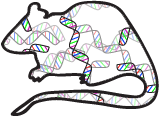 |
Contact Us Accessibility Accessibility Copyright & Citations Copyright & Citations Disclaimer & Privacy Policy Disclaimer & Privacy Policy
|
 |


 |
Navigation |  |
 |
Home / Latest News |  |
 Home / Latest News
Home / Latest News Contact
Contact Projects
Projects Services
Services Photo Gallery
Photo Gallery References
References Request a service
Request a serviceThe NIMH transgenic core facility offers services to the intramural neuroscience research community at the National Institutes of Health in Bethesda Maryland. These services include:
Gene targeting in embryonic (ES) cells A DNA targeting vector is introduced into ES lines. By homologous recombination the vector is inserted into the correct locus, but this occurs at a low frequency. So, resulting clones are selected and screened for the correct targeting. Correctly modified clones are expanded for blastocyst injections.
Transgenic ES lines The cell lines are produced when the DNA vector is not targeted to a specific locus but instead is integrated randomly into a chromosome. The resulting clones would be selected and screened for the presence of the transgene.
Blastocyst injections ES cells that carry a genetic modification are injected into the blastocoel of an early stage mouse embryos. Those embryos are transferred into foster mothers and are born as chimeras of the host embryo and the injected cells. When these chimeras become adults they are mated to determine if the transgene can be passed to subsequent generations through the germline.
Oocyte injections To produce mice in which the transgene is integrated randomly into the mouse genome the DNA is injected into the pronuclei of fertilized mouse eggs. These embryos are transferred into foster mothers and the resulting pups are screened for the presence of the transgene.
Cryopreservation and archiving of mouse lines Lines that have value for future research can be preserved by controlled rate freezing and storage in liquid nitrogen.
Production of ES lines Blastocyst stage embryos can be used as a source of stem cells from the inner cell mass. These can be induced to grow as ES lines which are self renewing and totipotent when injected into host embryos.
Rederivation of mouse lines When animals are introduced into the central animal facility or when frozen embryos are received they must be rederived in order to prevent the introduction of pathogens. This is achieved by transferring embryos into recipient foster mothers. After the pups are born their health status is determined before they are introduced into the animal holding facilty.
Invitro fertilization (IVF) of mouse oocytes with fresh or frozen mouse sperm. The embryos are then transferred to recipient females
 |
Contact Us Accessibility Accessibility Copyright & Citations Copyright & Citations Disclaimer & Privacy Policy Disclaimer & Privacy Policy
|
 |






